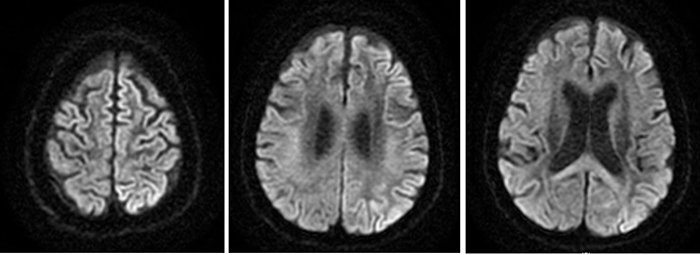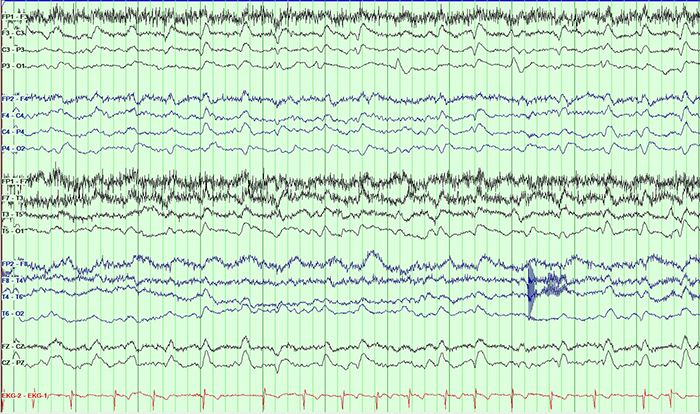September 2018
Featured Case
Submitted by: David Mao, MD and Nitin K Sethi, MD
Electroencephalogram findings in a patient with rapidly progressive dementia and myoclonus-helping to support the diagnosis of Creutzfeldt-Jakob disease: a case report
A 77-year-old right handed woman with a past medical history of hypothyroidism and vulvar cancer presented with two months of progressive cognitive decline and right sided tremors. Her symptoms included difficulty with word finding, calculating figures, and concentrating on tasks. On physical exam, there were deficits in multiple cognitive domains including language, processing speed, and memory. Ideomotor apraxia was present. Motor testing revealed 4/5 weakness on right side with myoclonus. MRI brain showed cortical diffusion restriction throughout the left cerebral hemisphere with minor involvement of right frontal cortex (Fig.1). Laboratory testing and initial cerebrospinal fluid (CSF) tests results (glucose, protein and cell count) were unrevealing. RT-QuIC analysis of CSF and protein 14-3-3 results are awaited.
An EEG study was requested to support the tentative diagnosis of Creutzfeldt-Jakob Disease (CJD). The routine 30 minute EEG was recorded with patient in awake state. It showed continuous diffuse theta and delta slowing with intermixed faster frequency wave forms. There were also intermittent burst of 1 Hz generalized periodic discharges (GPDs), without accompanying myoclonus (Fig. 2, 3, 4).
Figure 1: MR diffusion weighted images showing restricted diffusion of left cortex

Figure 2:

Figure 3:

Figure 4:

Figure 2, 3, 4: EEG epochs showing diffuse slowing and disease-typical 1 Hz generalized periodic discharges (GPDs) with mixed bi- and triphasic morphology. GPDs were referred to as periodic sharp wave complexes (PSWC) in older EEG nomenclature.
Question 1: What are recommendations for safe disposal of electrodes used in an EEG study carried out in a patient with CJD?
- There are no recommendations
- Standard sterilization precautions should be exercised
- Disposable electrodes should be used.
- All of the above
Answer: (click here)
A1: Correct answer: c.
Needle electrodes should not be used. Surface electrodes should not be reused and should be discharged as per recommendations after the study is completed. Best is to use disposable electrodes.
Question 2: What are the typical patterns found in the EEG of a patient with CJD?
- Delta brush
- Generalized paroxysmal fast activity
- Generalized periodic discharges (GPDs) or lateralized periodic discharges (LPDs))
- None of the above
Answer: (click here)
A2: Correct answer: c.
EEG has been included in the World Health Organization diagnostic classification criteria of CJD. In sporadic CJD (sCJD), the EEG exhibits characteristic changes depending on the stage of the disease. These changes range from nonspecific findings such as diffuse slowing and frontally predominant generalized rhythmic delta activity (GRDA) in early stages to disease-typical lateralized periodic discharges (LPDs) or generalized periodic discharges (GPDs) in middle and late stages to non-reactive coma traces or even alpha coma in preterminal EEG recordings. Periodic discharges occur in about two-thirds of patients with sCJD, with a positive predictive value of 95%. These discharges occur in patients with methionine homozygosity and methionine/valine heterozygosity but only rarely in patients with valine homozygosity at codon 129 of the prion protein gene. They also tend to disappear during sleep and may be attenuated by sedative medication and external stimulation. Seizures are an uncommon finding, occurring in less than 15% of patients with sCJD. In patients with iatrogenic CJD, these discharges usually present with more regional EEG findings corresponding to the site of inoculation of the transmissible agent. In genetic CJD, the discharges in its typical form are uncommon, occurring in about 10%. No typical discharges occur in EEG recordings of patients with variant CJD. 1
Question 3: What percent of patients with CJD develop seizures?
- <15%
- 25%
- 50%
- 85%
Answer: (click here)
A3: Correct answer: a.
Seizures are uncommon and occur in less than 15% of patients.1
References:
- Wieser HG, Schindler K, Zumsteg D. EEG in Creutzfeldt-Jakob disease. Clin Neurophysiol. 2006; 117:935-51.

